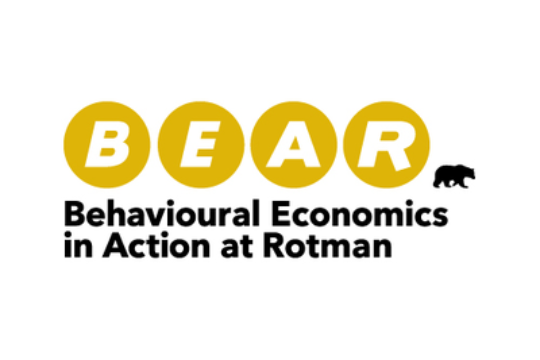FCLTGlobal’s research is designed to find practical solutions that encourage farsighted decision making within the investment industry. The work we do is primarily intended to explore how every actor on the investment value chain – corporations, asset owners, and asset managers – can put theory into action and reorient themselves and their counterparts toward the long-term. In order to arrive at the “how”, however, we must also explore why investors continue to make short-term decisions that sacrifice long-term value.
A team of researchers at the University of Toronto’s Rotman School of Management collaborated with FCLTGlobal to produce a report on ways to better communicate about long-term investment risk, proposing new ways to present the information to trustees. The group, Behavioral Economics in Action at Rotman (BEAR), studied how asset owners’ senior risk teams share information on investment risk with their boards of directors. The group reviewed academic literature in behavioral sciences and finance, covering theory as well as relevant experiments, and conducted direct interviews with global risk professionals. BEAR’s effort supports FCLTGlobal’s ongoing research regarding financial risk for long-term investors.
Information presented at trustee meetings often takes the form of technical data, rather than more easily digestible formats. A lack of clarity and the volume of information often result in sub-optimal investment decisions. The lengthy tables that investors often present to trustees do not adequately communicate risks to the Board, BEAR found, because most people understand risk both as a number and as a byproduct of intuition and experience. Overly data-heavy discussions impair Directors’ decision-making through:
- Cognitive overload: The quarterly reviews between the risk team and Board of Directors cover a diverse range of issues impacting investment risk, bombarding the Board with technical information, not all of which is customized to a board director or trustee’s function. Unnecessary information in the risk presentation often comes at the expense of higher-priority, long-term concerns.
- Perceived complexity: This phenomenon plays a significant role in the amount of risk that is perceived by the Board. When directors are presented with complex tables, the investments are seen as riskier.
- Lack of salience: Too often, risk presentations are highly technical and can obscure crucial insights embedded within the tables and values presented to the Board, making the information harder to fully comprehend.
In light of these common difficulties, the group developed several recommendations that can foster longer-term investment decisions, including:
- Employing more visual aids to accompany financial metrics in the investment presentation: This change would reduce the effects caused by the perceived complexity and aforementioned lack of salience often experienced by Boards of Directors when presented with risk data. While risk managers typically use metrics in investment presentations, BEAR recommends utilizing more graphs, which would make the information more readily comprehensible.
- Annotating materials sent prior to Board meetings: Adding additional context can address the perceived complexity bias, where directors may not be confident in the information presented because it seems too complicated and assume greater risk. Annotations would not only explain the intuition and insights behind the metrics and values presented, but they would also further elaborate on the assumptions made by the risk team.
The study also found that rearranging the risk information within the order of the Board’s agenda could help avoid the aforementioned roadblocks. These may appear to be straightforward suggestions, but in sharing these findings with risk professionals in the FCLTGlobal community, we’ve learned that these practices have not yet fully taken hold among notable asset owners. As they find their way into more risk presentations moving forward, we expect these techniques to improve both comprehension and decision-making as it relates to investment risk and opportunities.
BEAR’s research shows that there are opportunities to improve the way in which risk is communicated to boards. In order to instill a more long-term investment strategy, institutions can take a more behavioral approach when assessing risk by using the recommendations and avoiding the pitfalls presented in this report.
Read Encouraging Long-Term Thinking by Organizations Making Investment Decisions
